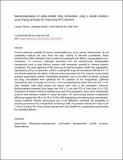| dc.contributor.author | Tshweu, Lesego | |
| dc.contributor.author | Katata, Lebogang | |
| dc.contributor.author | Kalombo, Lonji | |
| dc.contributor.author | Swai, Hulda | |
| dc.date.accessioned | 2020-12-29T11:34:05Z | |
| dc.date.available | 2020-12-29T11:34:05Z | |
| dc.date.issued | 2013-10-22 | |
| dc.identifier.uri | https://doi.org/10.1007/s11051-013-2040-4 | |
| dc.identifier.uri | https://dspace.nm-aist.ac.tz/handle/20.500.12479/1074 | |
| dc.description | This research article published by Springer Nature Switzerland AG., 2013 | en_US |
| dc.description.abstract | Current treatments available for human immunodeficiency virus, namely antiretrovirals, do not
completely eradicate the virus from the body, leading to life-time commitment. Many
antiretrovirals suffer drawbacks from toxicity and unpleasant side effects, causing patience noncompliance.
To minimize challenges associated with the antiretrovirals, biodegradable
nanoparticles used as drug delivery systems hold tremendous potential to enhance patience
compliance. The main objective of this work was to load lamivudine (LAM) into poly(epsiloncaprolactone)
(PCL)
nanoparticles.
LAM
is
a hydrophilic
drug
with low
plasma
half-life
of
5–7
h
and
several
unpleasant
side
effects.
LAM
was
nanoencapsulated
into
PCL
polymer
via
the
double
emulsion
spray-drying method. Formulation parameters such as the effect of solvent, excipient
and drug concentration were optimized for the synthesis of the nanoparticles. Spherical
nanoparticles with an average size of 215 ± 3 nm and polydispersity index (PDI) of 0.227 ± 0.01
were obtained, when ethyl acetate and lactose were used in the preparation. However,
dichloromethane presented sizes larger than 454 ± 11 nm with PDI of more than 0.4 ± 0.05,
irrespective of whether lactose or trehalose was used in the preparation. Some of the nanoparticles
prepared with trehalose resulted in crystal formation. UV spectroscopy showed encapsulation
efficiency ranging from 68 ± 4 to 78 ± 4 % for LAM depending on the starting drug concentration.
Fourier transform infrared spectroscopy and X-ray diffraction confirmed the possibility of
preparing amorphous PCL nanoparticles containing LAM. Drug release extended for 4 days in pH
1.3, pH 4.5 and pH 6.8. These results indicated that LAM-loaded PCL nanoparticles show promise
for controlled delivery. | en_US |
| dc.publisher | Springer Nature Switzerland AG. | en_US |
| dc.subject | Spray-dried | en_US |
| dc.subject | Poly(epsilon-caprolactone) | en_US |
| dc.subject | Lamivudine | en_US |
| dc.subject | Nanoparticles | en_US |
| dc.subject | Double emulsion | en_US |
| dc.subject | Nanomedicine | en_US |
| dc.title | Nanoencapsulation of water-soluble drug, lamivudine, using a double emulsion spray-drying technique for improving HIV treatment | en_US |
| dc.type | Article | en_US |

